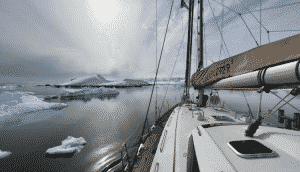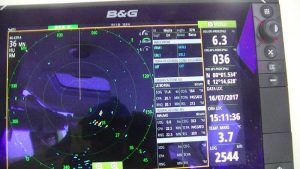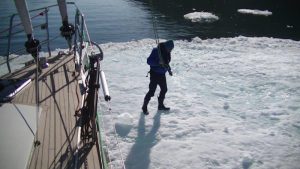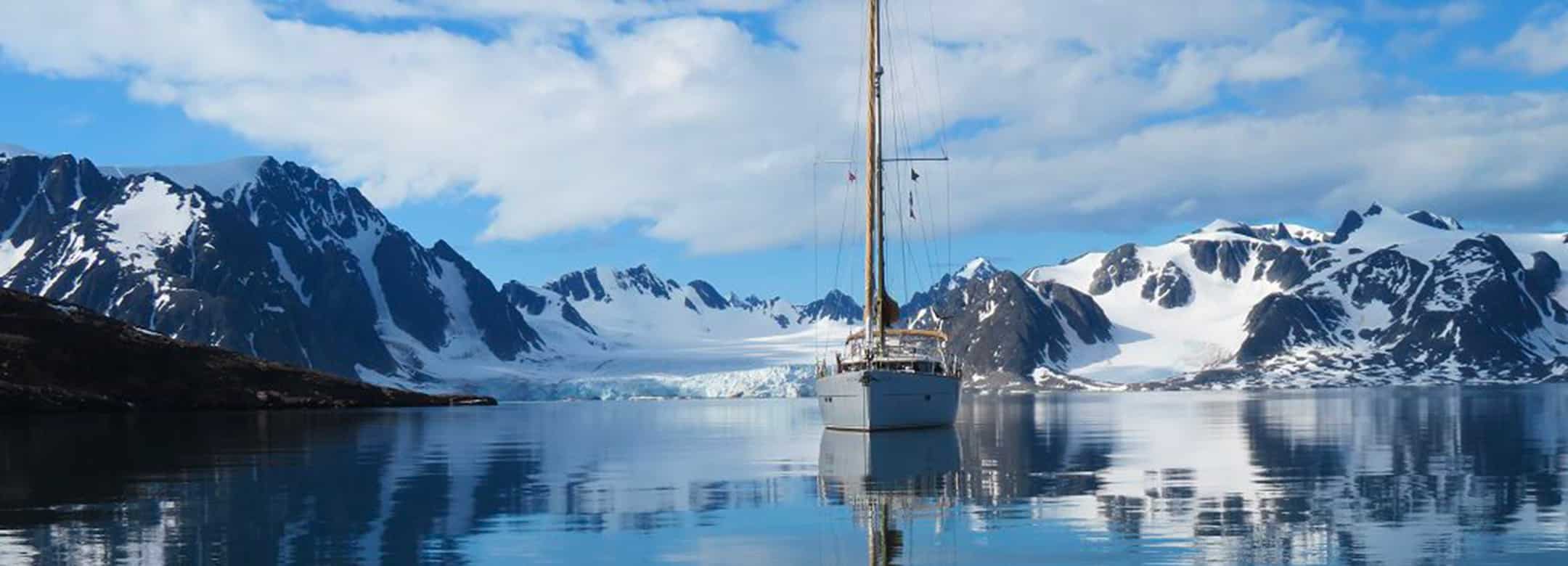Part 1: Towards high northern latitudes
From Svalbard to the Antarctic Peninsula via Patagonia, the Italian crew of the Garcia Exploration 52 Lifexplorer opted for the most remote destinations to carry out a passage plan in circumpolar regions which left nothing to chance. This is the first part of a narrative which will ultimately take us to Patagonia and the Antarctic Peninsula.
A promise from the beginning
Everything can be summed up in one word, and ‘Lifexplorer’, the name of this boat, provides real promise no matter what the language! Delivered in April 2017, Lifexplorer is a Garcia Exploration 52 which Alberto, its owner from the north of Italy, bought in order to carry out a passage plan with family and friends on board, aiming to reach high latitudes.
Alberto had previously been the owner of ‘Onelife’, a Super Maramu from the Amel shipyard in La Rochelle, which he entered with friends into the prestigious Sydney Hobart race in 2010. He described in his blog how, on board between 2005 and 2016, he had enjoyed ‘great experiences around the world, crossing oceans, straits, and atolls, gaining unexpected victories and sharing real life moments’. But ‘we had to move on’, as he starkly wrote in his blog, which can be accessed via the address lifexplorer.navy.
A well-defined plan, and the boat to go with it
So it was with the Garcia Exploration 52 that Alberto discovered an ocean-cruiser sailboat design which was capable of going along with his dreams of sailing in circumpolar regions. The ‘Lifexplorer 2016–2026’ project took shape. Led by Alberto and always involving the same group of friends and relatives, the project consists of a passage plan of 30 to 120 days per year which can be broken down into two sections that could easily have been mapped out by a child putting their finger on a map of the world: first of all, the northern high latitudes, and then those in the south. Needless to say, at the half-way point of the ‘Lifexplorer 2016–2026’ project, this promise has been entirely kept so far: for Alberto, this has been a matter of personal conviction and a desire to fulfil his dreams. He often refers back to the golden age of polar exploration and aims to go to places which would be worthy destinations for a Shackleton, an Amundsen or a Nobile.
Sturdy with its aluminium hull, well insulated, highly independent and able to carry food, equipment and water and fuel reserves for long journeys, the Garcia Exploration 52 combines these features – which make it a sought-after model for people who love sailing in remote areas – with the chance to clock up nautical miles on a regular basis and reach areas that are deemed inaccessible for ordinary sailing boats. In addition, whilst providing the crew with a comfortable interior and a level of protection, which are no luxury when the weather conditions make any attempt to go outside and sniff the air a challenge, the Garcia Exploration 52 would be a sensible choice for the most highly committed sailing enthusiasts. It’s no wonder that Alberto, who was looking for a sturdy and accommodating 50 to 55-foot passagemaker cruiser, should opt for this twin-rudder centreboarder, which he first saw at the Düsseldorf Boat Show in January 2016.

From the Channel to the icy Arctic Sea via the Irish Sea
Having left Cherbourg, and then been officially launched in June 2017 in the fishing village of Howth near Dublin, Lifexplorer went on to cross the Irish Sea in order to reach Inverness (Scotland), and headed north in mid-July 2017 towards the Norwegian archipelago of Svalbard. Up there, it got to Longyearbyen on the Island of Spitzbergen at latitude 78° north, far beyond the Arctic Circle at 66° 33’ N.
It was very tempting, having got ‘so high up’ on the globe, to reach the north of the Svalbard archipelago and cross the 80°N line, thereby sailing for a few nautical miles in the famous Arctic Ocean. It must be said that the daylight, which is almost permanent up there at that time of the year, greatly facilitated sight navigation close to land which has sometimes only been mapped out haphazardly. This legendary latitude was crossed a few days later, on 16 July to be precise, as shown by a photo from the B&B chartplotter screen. This resulted in Lifexplorer coming up against its first ice floes and observing a polar bear up close the following day. What powerful moments and guaranteed lasting memories!

When its progress was sometimes slowed down by packs of drift ice, the crew had the chance to observe some of the wildlife on Svalbard. Reindeer, walruses, puffins and other skuas didn’t seem to mind being photographed. Resupplying at Longyearbyen (‘Fare cambusa’ was what was written in Italian in Alberto’s blog – an expression more stimulating for the tastebuds than the actual food supplies available in these northern regions), Lifexplorer headed south at the end of July, towards the Lofoten Islands and Norwegian coast. On the way, Garcia Exploration 52 stopped over at Bear Island, the southernmost island of the Svalbard archipelago. This is, in fact, nothing more than a god-forsaken rock measuring 175km2 at 74°N and 18°E that forms a nature reserve and which currently has no other human activity than a modest weather station.

Quick and sometimes rough crossings
At the end of July 2017, Lifexplorer reached the Lofoten Islands which are located off Norway at 68°N. It had covered 350 miles in 42 hours, with a northeast inflow of 25 to 35 knots, at an average speed of more than 8 knots and with surf waves reaching 12 knots, on the Barents Sea which had fully developed waves due to the strong counter-current. By exploring the fjords and other wonderful landscapes in this archipelago, the crew got some rest after the rough sailing of the previous days. With the start of August, the Arctic autumn was approaching along with several months of night and non-stop storms. After a quick crossing over to Bodø and some days exploring the fjords in the coastal region in central Norway, Lifexplorer reached Bergen on 15 August, followed by Stavanger in Sweden. On 24 August, it docked in Den Helder, in the Netherlands, after a 30-hour-long crossing made at an average speed of 7.7 knots.
Then Alberto and his team escorted Lifexplorer across the closed-off bay of Ijsselmeer to Hoorn, having first taken part in a very direct way in rescue training exercises carried out by a helicopter of Royal Netherlands Air Force Search and Rescue Unit. This was an impressive occasion that was once again rich in memories, especially for Matteo, the youngest member of the crew on board, who was chosen by the rescuers so they could try out a hoist manoeuvre in order to hone their skills! Several days later, Lifexplorer took part in the Amsterdam boat show under the colours of Garcia Yachts, before going back to Cherbourg where the boat overwintered in the boatyard. A well-deserved break for everybody, after three months of adventures at sea.
First major step taken
Alberto wrote in his blog: ‘We have taken the first major step in our project: the Northern High Latitudes phase, with a test of no less than 5000 nautical miles, with few problems and with the great satisfaction of having achieved all our exciting goals, as efficiently and easily as we could have expected. What was impressive was the size of the geographical area covered, from 48°51’ to 80°02’ North, and from 6° West (Dublin) to 19° East (Bear Island).’
We are soon going to be joining Alberto and his friends on board Lifexplorer so we can talk about the southern part of the ‘Lifexplorer 2016–2026’ expedition to Patagonia and the Antarctic Peninsular, while hoping that we can get an update on the crew, which, on 10 January 2022, was sailing at 62°S near to the South Shetland Islands. And to think we had been talking to you about high latitudes!
Images by Lifexplorer’s team, http://www.lifexplorer.navy/.









